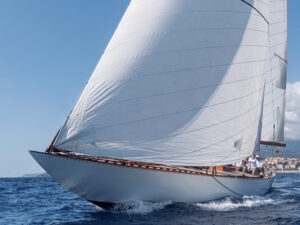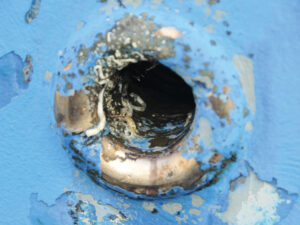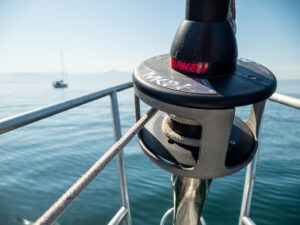Marine diesel engines have millions of hours of reliable running time to their credit. As a class, they represent a mature technology–so much lighter, smaller, and safer than their forebears of a generation ago that the gasoline inboards they replaced are virtually gone but for the history. When it comes to building new auxiliary sailboats, it would seem that the propulsion question is a problem solved. End of story.
But a growing number of sailors and boatbuilders, drawn to the promise of diesel-electric technology, are beginning to think otherwise. At the center of this trend is a 10-year-old company called Solomon Technologies Inc. (STI; www.solomontechnolo gies.com), which went public in January 2004 and has attracted the attention of such boatbuilders as Alliaura (Privilege), Hinckley, Island Spirit, Lagoon, Manta, and others who are beginning to install STI’s electric motors at the factory.
“I’d been documenting electric propulsion for 15 years when I first saw the Solomon solution in 2000,” says Bruno Belmont, who directs research and development for Lagoon, Wauquiez, and CNB within Groupe Beneteau. “It was the first setup that made sense to me. I strongly believe that electric propulsion is the future and that all the Lagoon boats will be electrical within five years.”
The Promise
Advocates for diesel-electric propulsion list among its virtues that it’s clean, quiet, efficient, and requires very little maintenance. Another advantage frequently noted in connection with the STI system is the ability to make electricity–to “regenerate”–when the boat is under sail.
There’s nothing new about electric propulsion per se. In 1879, a Philadelphia man named William Woodnut Griscom invented the first electric motor for marine use. Since then, electric motors have pushed tugboats, icebreakers, submarines, cruise ships, and other commercial and military vessels. In 1893, 55 electric boats built by the Electric Launch Company, or Elco, ferried passengers around the Colombian Exposition in Chicago; a reorganized Elco still builds electric boats on the Hudson River today. For decades, companies like Siemens and General Electric have built electric motors for commercial use. Since 1970, the Duffy company in Southern California has been building electric boats from 16 to 30 feet. In Europe, electric power has been used in small recreational boats for decades. Today, electric motors are installed in classic runabouts that can attain planing speeds.
But until recently, no electric-motor system convinced boatbuilders that it was viable enough to be installed in production cruising sailboats.
David Tether set out to change all that. In 1994, he founded Solomon Technologies. Tether is a big, engaging fellow with a mad scientist’s air. “I have pattern-recognition capability,” he says, by way of introduction. He speaks passionately, often a step or two ahead of his listener, and makes quips like “Time flies when you’re in a paradigm shift.” He gives the impression of a man who sees the world not as it is but as it could be–and who knows how to get it there.
“Meeting with Dave Tether led me to believe that his system could well be the best there is,” says Belmont. “That man is a genius.”
Beginning in 1969, Tether wrote software and conducted research for the U.S. Navy. One of his projects was to study the infrared and electromagnetic spectrosignatures from various craft. “I noticed that the emissions from diesel-electric tugboats were far reduced from other boats,” Tether says. “Studying it further, I noticed that it was all directly due to efficiency.” That was in the early 1980s, and for seven or eight years, he says, “I just pondered that.”
Toward the end of the decade, he teamed up with a man he describes as a junkyard inventor who had an idea for an infinitely variable transmission employing a system of planetary gears driven by two electric motors. In the early 1990s, they patented the Electric Wheel; since then, NASA has put a version of it on the Mars Rover. Says former NASA administrator David Golden, “The Electric Wheel has application to everything that moves.”
As Tether was developing the Electric Wheel, he had grand visions about revolutionizing the car industry. He even met with automobile executives. Though he’s reluctant to speak about exactly what was said in those conversations, Tether reckons he was lucky to get out of Motown alive. He went back to his whiteboard and determined that the marine industry, being unregulated, was perhaps the better place to start putting his ideas to the test.
“What we did then,” Tether says, “is we designed an electric motor specifically to push propellers.” He believes that was something new in the marine industry. “If you see the diesel-electrics that Siemens or GE have done,” he says, “they’ve taken a motor off the shelf that used to push a bus or open a bridge or run a monster conveyor, a motor that was kind of almost what we needed, and they’ve emulated what had been done with fossil-fuel motors.”
Tether’s approach was to start with a blank sheet and look at the whole boat. His line of thinking went like this: “We’ve got a propeller. What exactly does it need? And in order that I can have renewable input, I have batteries. What exactly do they want?”
Following this process, he says, he worked toward the middle. “When I got to the middle, I knew how much torque, what rpm, what voltage, and what amperage I needed to design an electric motor for.”
The solution that he found wasn’t a geared transmission like the Electric Wheel but a mechanically simpler system based on a brushless 144-volt DC motor that uses powerful permanent magnets instead of field windings and an electronic commutator instead of brushes. The result is a motor that demands very little maintenance. Roller-thrust bearings at either end of the stainless-steel shaft–among the motor’s very few moving parts–are rated for 150,000 hours of use. Compare that to a diesel engine’s valves, pistons, cylinders, rings, crankshaft, camshaft, fuel injectors, gaskets, filters, pumps, and transmission.
The difference, Tether says, accounts for not just an improvement in the maintenance schedule but also a dramatic increase in efficiency over diesel engines.
“It was almost our nemesis early on,” he says, because nobody would believe the results he was getting. He eventually found that he could install his electric motors in boats that called for diesels with horsepower ratings that were four times higher.
Tether prefers to describe the output of the STI motors in terms of torque (force times distance) rather than horsepower (force times distance per time). While internal-combustion engines are typically described by their horsepower rating, STI’s motors are named for the torque they develop. An ST 37 puts out 37 foot-pounds of torque or 6 horsepower; Tether recommends using it on monohulls up to 32 feet and 10 tons or to replace diesel engines of up to 24 horsepower. An ST 74 puts out 74 foot-pounds of torque or 12 horsepower; Tether recommends using it on monohulls up to 50 feet and 16 tons or to replace diesel engines of up to 48 horsepower.
What accounts for the difference in efficiency between electric and diesel power plants? Consider the typical internal-combustion engine. From the time a charge of fuel ignites in a cylinder, it has to push pistons, turn a crankshaft, turn a camshaft, open valves, pump water, pump oil, turn an alternator, and submit to reduction from a transmission to step the engine’s thousands of revolutions down to something a propeller can use. By the time that’s done, the engine’s efficiency is somewhere below 25 percent. Also, diesel engines are rated at their maximum rpm–and on sailboats are rarely operated at that speed.
By contrast, Tether says, the efficiency of the STI motor is a percentage in the low 90s. Here’s how it works: When the system is switched on, DC current from the batteries enters an electronic controller, which produces expanding and contracting magnetic fields in the motor’s stator windings. These magnetic fields attract and repel the fields from three permanent magnets, made from neo-dymium iron boron, that are attached to the rotor. The controller electronically modulates the pulse width to increase or decrease speed. At 13 inches wide, the motor provides ample contact with the shaft to produce high torque at low rpm, enough for the motor to turn particularly large propellers. Fixed three-bladed 18/18 (diameter/pitch, in inches) propellers are typical in many of STI’s installations. From the flowing electrons to the turning prop, the shaft passes through only two bearings and a stern gland–and no transmission, all of which accounts for its high efficiency. Furthermore, with the electric motor, the relationship between rpm and torque is linear: You can use it to turn the boat’s prop at 1 rpm or 10 rpm or 50 rpm or 100 rpm. An internal-combustion engine needs to cross an rpm threshold before its propeller is put in gear; otherwise, it would stall.
One topic that proponents of the STI system rave about is “regeneration”–its ability to produce electricity when a boat is under sail. We described how current from the batteries turns the prop. When the boat’s under sail, the same process works backward, converting the prop’s rotation into stored energy.
“The way this thing regenerates,” says Tether, “is it builds up energy in the windings, then dumps that energy in a big pulse, which is the best way in the world to charge batteries. If you put a steady charge on them, you end up wasting a lot of energy and you heat them up too much and you boil them and do all kinds of crazy things that they don’t like. But if you zap them with pulses, they love it.”
Dennis English was the first customer to have STI motors installed in a production boat by the factory, a Lagoon 410 called Waypoint (www.sailingwaypoint.com). He was originally drawn to electric propulsion because he thought it was an environmentally friendly technology. “Regeneration is really the cool part of this system,” he says.
He describes his experience from a recent passage: “We sailed from Norfolk, Virginia, to Tortola in 8 days, 2 hours. For a couple of days, we had almost no wind, and we ran the genset 24/7. But for two straight days we had 20 knots of breeze and 15-foot swells. On those days, we put the motors on slightly, which gave us an extra knot of boat speed up the waves. Down the waves, though, it regenerated. For two days we ran the refrigerator, freezer, air-conditioner, stereo, and nav electronics without making electricity from any other source.”
“It was gorgeous,” he says. “That’s what it’s made for.”
So Where’s the Rub?
In general, the STI system trades routine diesel maintenance for a level of vigilance toward the boat’s electrical system that’s probably new to most operators.
The basic STI system includes not just the drive unit but also the electronic controller, a battery bank, power-distribution buses, and a shore-power battery charger. This basic system is intended for daysailors and weekenders who typically return to a dock at the end of the day. For long-term cruisers and voyagers, STI recommends adding a diesel genset, which would also provide ample current for refrigeration, air-conditioning, a microwave, and other big-draw gadgets.
The Solomon Technologies system is different from most other systems offering electric propulsion in that it runs on high-voltage direct current (144-volt DC) supplied by a battery bank. That has several implications. It reduces the amperage, and therefore the wire gauge, throughout the system, but it also means that you’ve got to forget everything you’ve been taught about how DC current is safer than alternating current. At this voltage, it’s lethal. What’s more, the organizations that develop standards for sound boatbuilding practices haven’t addressed high-voltage DC, which they define as anything above 50 volts. This is new territory for the whole marine industry; apart from STI and the boatbuilder, there’s no third-party consensus on such safety issues as grounding.
How do you create a 144-volt DC system? Basic electric theory tells us that a single lead-acid cell delivers roughly 2 volts of electricity. A typical marine battery consists of six cells connected in series to deliver a nominal 12 volts. The size of the battery’s plates determines its capacity, measured in amp-hours. If you connect multiple batteries in series (the positive post of one battery to the negative post of another), the voltage of the bank you’ve created is the sum of the voltage of the connected batteries. If you connect multiple batteries in parallel (positive post to positive post), the capacity of the bank you’ve created is the sum of the capacity of the connected batteries.
The Solomon system depends on a bank of 12 batteries to run the system, plus two for the house. So two downsides of the system are the weight and cost of the batteries: Twelve 4D absorbed-glass-mat batteries weigh 1,620 pounds and cost $3,750. Another potential downside also follows from basic electrical theory: When a bank of batteries is wired in series, one bad cell (in this case, just one out of the total of 72 cells) can take down the whole bank. Here’s a case where the operator has to pay close attention to the system.
Then there’s the question of depending on a genset for all your propulsion. When Tether started out, there were no DC gensets available on the market. That’s changing now, but some folks had genset problems early on.
To address these concerns, Tether, knowing full well that he’s asking customers to tread into terra incognita, warrants the entire system. “It doesn’t matter what breaks on the system–whether it’s the motor, the inverter, the generator, the wiring, the switches, the throttle controls–you call one person. Me.”
Dennis English says he’s had only two problems with the system. The first was easily solved once it was identified. The 15-kilowatt genset performed poorly early on, but it only needed better ventilation. The second problem English attributes to operator error: He was showing off. “You can go immediately from forward to reverse without neutral,” he says. “There’s no transmission, so the motors don’t care.”
True enough. But propeller-shaft shear pins do. English says he was demonstrating to a friend how the motors can take his 10-ton boat from 8 knots to a dead stop in just two boatlengths. “I slammed into reverse, and there was so much torque it snapped the shear pin.”
Because he put Waypoint into charter, English says he made one small ergonomic change, swapping little joystick controls for true throttle arms. “With the joysticks, people didn’t realize how much power they were putting out.”
Another drawback, for the moment anyway, is the cost. The initial installation is more expensive than that of a conventional diesel auxiliary. For an ST 37, the electric motor itself costs about $10,000. The entire system–which includes 4D batteries, cables, meters, a charger, a throttle, a 3-kilowatt inverter, and a 6-kilowatt genset–costs about $35,000. Of that, the genset accounts for $11,000. An ST 74 motor, recommended to replace diesels up to 48 horsepower, costs $12,000. That entire system, including the same extras but with 8D batteries, a 6-kilowatt inverter, and a 9-kilowatt genset, costs just over $40,000.
Greg Gerken ordered the second electric Island Spirit 401. He reckons the electric-propulsion option on his boat cost an extra $11,000 when compared to a standard propulsion package, taking into account that he would have installed two diesels and a genset anyway. Tether believes that through production efficiencies, the price will soon be comparable to that of a conventional diesel.
On the topic of regeneration, of course, nothing is free. When a guest during a demonstration sail last fall asked Tether whether with the STI system he’d achieved perpetual motion, he was quick to nip that notion in the bud. “No, no: perpetuated motion,” he said. Tether reckons that using the motors in regeneration mode with big fixed-bladed props in light air costs as much as a knot of boat speed in monohulls and two knots in multihulls. For those who aren’t keen on making that trade, installations with feathering props are also possible.
One drawback that can’t be overlooked is the one that can only be called the X factor. Today, the number of installations of STI’s electric motors number in the tens, not in the tens of thousands let alone the hundreds of thousands. At press time, Tether said he’s put roughly 50 STI propulsion systems in 40 boats (10 of these catamarans). In the arena of recreational boats, these drives must still be considered an emerging technology.
What the Future Holds
Given the capital that came with last January’s public offering and given the commitments of several boatbuilders to begin offering STI electric motors from the factory, it appears we can expect to see many more electric boats in the coming years. What does that mean for the future of the technology?
There will clearly be competition. Fischer Panda (www.fischerpanda.com) recently introduced a diesel-electric motor that runs not from a large battery bank but directly from a running genset.
Certainly, we can expect that improved methods for storing and producing electricity will come into play. Tether says he’s deliberately created the STI system in a modular way so that, for instance, nickel-metal-hydride or lithium-ion batteries–which have a significantly higher power density than lead-acid batteries do–can be introduced as soon as big enough ones are available. On the energy-production side, of course, it’s all the rage these days to talk about fuel cells, though Tether is dubious about storing the hydrogen fuel aboard a boat. So, if not fuel cells, what lies in the future, then?
“Steam,” says Tether, with a twinkle in his eye, obviously relishing the Robert Fulton anachronism.
“I’m looking into steam cells.”
Tim Murphy is CW’s executive editor.








